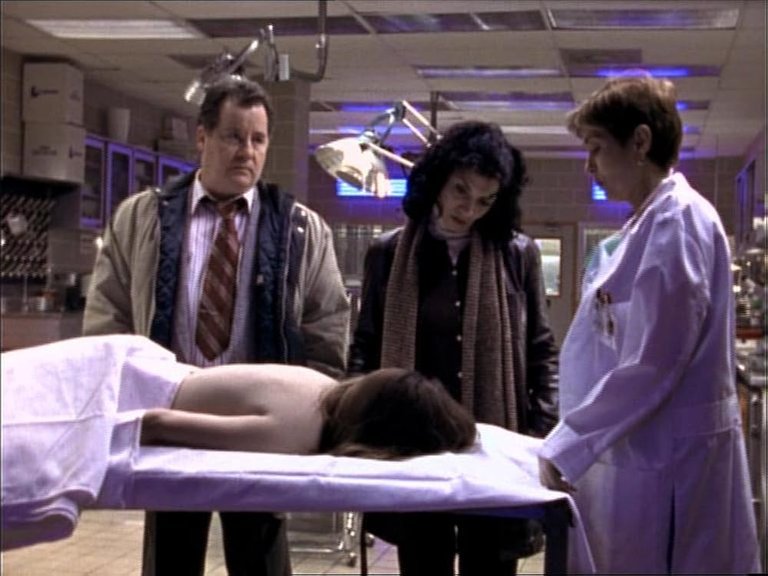Television Review: Strangled, Not Stirred (Homicide: Life on the Street, S6X19, 1998)

Strangled, Not Stirred (S06E19)
Airdate: 18 April 1998
Written by: Linda McGibney
Directed by: Jay Tobias
Running Time: 45 minutes
In its final seasons, Homicide: Life on the Street began to drift from its original ethos of gritty realism, increasingly adopting the procedural formula popularised by Law & Order. This shift manifested in episodes like Strangled, Not Stirred, which drew heavily from real-life criminal cases—specifically, those deemed “redball” in police jargon: sensational, high-profile crimes that rarely reflect the mundane reality of police work. While the show’s earlier seasons thrived on the unpredictability of everyday homicide investigations, its later years leaned into fictionalised versions of real-world atrocities, paradoxically undermining its authenticity. These episodes, though ostensibly grounded in reality, often relied on hyper-dramatic scenarios that prioritised shock value over plausibility. Strangled, Not Stirred, a Season 6 instalment, epitomises this tension, blending a ripped-from-the-headlines narrative with uneven characterisation and rushed subplots.
The episode opens in a bar on a Saturday night, where Jennifer Gerrick (Portia Thomas), a lonely woman seeking companionship, engages in casual conversation with Nick Montgomery (Jack Gwaltney) and his wife Helen (Francie Swift). By morning, Jennifer is found strangled, her body bearing marks from a stun gun—a detail uncovered by pathologist Dr. Alyssa Dyer (Harlee McBride). Detectives Ballard (Callie Thorne) and Gharty (Peter Gerety) initially face a barren investigation, with scant physical evidence or leads. Their pursuit of suspects begins with the victims’ frequent haunts, leading to fruitless interrogations of bar staff and restaurant managers. The case takes a turn when a second strangled woman, also incapacitated by a stun gun, is discovered. Suspicion shifts to the Montgomerys, though their initial portrayal as a seemingly normal, even charming couple—Helen’s hostility toward Nick and her eventual surrender of the stun gun to the detectives complicates the narrative. Nick confesses to the murders but implicates Helen as the mastermind, tracing their spree to her sister’s unsolved death, which she allegedly orchestrated. The plot hinges on the Montgomerys’ twisted dynamic, blending marital dysfunction with psychopathy, yet their motivations remain underexplored, reduced to clichéd tropes of sexual deviance and psychological manipulation.
Parallel to this case is the ongoing “Luther Mahoney Saga,” in which detectives grapple with the fallout of Mahoney’s drug empire. Tips from an anonymous informant—revealed to be suspended Detective Lewis (Clark Johnson), aided covertly by Detective Falsone (Jon Seda)—enable rapid progress. Lt. Giardello (Yaphet Kotto) informs Lewis that his suspension will end but that he’ll likely be reassigned from Homicide. This subplot, while tying into the broader narrative of institutional corruption, feels rushed and overly convenient. The apparent resolution of Mahoney’s plotline lacks the nuance of earlier instalments, prioritising procedural neatness over the moral ambiguity that defined the series’ earlier seasons. Lewis’s swift reinstatement, though a nod to his tenacity, undermines the tension of his suspension, rendering the subplot a perfunctory addendum rather than a meaningful character arc.
The episode’s reliance on the real-life crimes of Canadian couple Paul Bernardo and Karla Homolka, on whom the Montgomerys are loosely based, highlights writer Linda McGibney’s ambition to inject topical relevance. Bernardo and Homolka’s atrocities—centring on sexual violence and murder—were indeed headline-grabbing, but their adaptation here amplifies the show’s sensationalism. The casting of Gwaltney and Swift, whose unusually good looks jar with the show’s otherwise unglamorous aesthetic, further distances the narrative from its blue-collar roots. The Montgomerys resemble figures from daytime soap operas, their evil tempered by an unsettling allure that clashes with the show’s gritty realism. This dissonance underscores a broader creative conflict: Homicide’s attempt to balance its documentary-like style with the heightened drama of its later seasons.
McGibney’s efforts to ground the episode in procedural authenticity are evident in Detective Ballard’s internal conflict. Her personal connection to the case—rooted in her own loneliness and vulnerability—adds emotional weight, contrasting with her professional detachment. Her refusal to consider Helen Montgomery as suspect, however, is initially dismissed by Gharty, whose open-mindedness ultimately proves correct. This dynamic subtly critiques gendered assumptions about criminality, yet it feels underdeveloped, a missed opportunity to explore deeper themes of power and complicity.
The Mahoney subplot’s flaws are emblematic of the episode’s broader structural issues. The anonymous tips and Lewis’s reinstatement proceed with a lack of suspense, their resolutions feeling predetermined rather than earned. This expediency reflects a broader trend in the series’ later seasons, where subplots are jettisoned to prioritise the week’s headline-inspired case. The rushed pacing undermines the Mahoney saga’s potential to interrogate systemic corruption, instead reducing it to a backdrop for procedural mechanics.
Ultimately, Strangled, Not Stirred is a competent but unremarkable entry in Homicide’s canon. While it successfully transplants the Bernardo-Homolka case into its narrative framework, the episode’s reliance on sensationalism and its compromised subplots signal the show’s drift from David Simon’s original vision. His book Homicide: A Year on the Killing Streets, which inspired the series, prioritised the banality of police work and the moral ambiguities of urban life. By the sixth season, however, the programme increasingly chased relevance through high-profile cases, sacrificing the nuanced character studies and procedural authenticity that once defined it. Strangled, Not Stirred serves as a microcosm of this shift—a competent but forgettable instalment that prioritises shock over substance, marking the beginning of the end for one of television’s most daring police dramas.
RATING: 5/10 (++)
Blog in Croatian https://draxblog.com
Blog in English https://draxreview.wordpress.com/
InLeo blog https://inleo.io/@drax.leo
Hiveonboard: https://hiveonboard.com?ref=drax
Rising Star game: https://www.risingstargame.com?referrer=drax
1Inch: https://1inch.exchange/#/r/0x83823d8CCB74F828148258BB4457642124b1328e
BTC donations: 1EWxiMiP6iiG9rger3NuUSd6HByaxQWafG
ETH donations: 0xB305F144323b99e6f8b1d66f5D7DE78B498C32A7
BCH donations: qpvxw0jax79lhmvlgcldkzpqanf03r9cjv8y6gtmk9